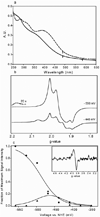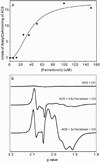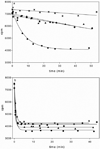Evidence that ferredoxin interfaces with an internal redox shuttle in Acetyl-CoA synthase during reductive activation and catalysis
- PMID: 21141812
- PMCID: PMC3077469
- DOI: 10.1021/bi101511r
Evidence that ferredoxin interfaces with an internal redox shuttle in Acetyl-CoA synthase during reductive activation and catalysis
Abstract
Acetyl-CoA synthase (ACS), a subunit of the bifunctional CO dehydrogenase/acetyl-CoA synthase (CODH/ACS) complex of Moorella thermoacetica requires reductive activation in order to catalyze acetyl-CoA synthesis and related partial reactions, including the CO/[1-(14)C]-acetyl-CoA exchange reaction. We show that the M. thermoacetica ferredoxin(II) (Fd-II), which harbors two [4Fe-4S] clusters and is an electron acceptor for CODH, serves as a redox activator of ACS. The level of activation depends on the oxidation states of both ACS and Fd-II, which strongly suggests that Fd-II acts as a reducing agent. By the use of controlled potential enzymology, the midpoint reduction potential for the catalytic one-electron redox-active species in the CO/acetyl-CoA exchange reaction is -511 mV, which is similar to the midpoint reduction potential that was earlier measured for other reactions involving ACS. Incubation of ACS with Fd-II and CO leads to the formation of the NiFeC species, which also supports the role of Fd-II as a reductant for ACS. In addition to being a reductant, Fd-II can accept electrons from acetylated ACS, as observed by the increased intensity of the EPR spectrum of reduced Fd-II, indicating that there is a stored electron within an "electron shuttle" in the acetyl-Ni(II) form of ACS. This "shuttle" is proposed to serve as a redox mediator during activation and at different steps of the ACS catalytic cycle.
Figures






Similar articles
-
Role of the [4Fe-4S] cluster in reductive activation of the cobalt center of the corrinoid iron-sulfur protein from Clostridium thermoaceticum during acetate biosynthesis.Biochemistry. 1998 Apr 21;37(16):5689-98. doi: 10.1021/bi9727996. Biochemistry. 1998. PMID: 9548955
-
Evidence that NiNi acetyl-CoA synthase is active and that the CuNi enzyme is not.Biochemistry. 2004 Apr 6;43(13):3944-55. doi: 10.1021/bi036194n. Biochemistry. 2004. PMID: 15049702
-
Different modes of carbon monoxide binding to acetyl-CoA synthase and the role of a conserved phenylalanine in the coordination environment of nickel.Biochemistry. 2013 Mar 12;52(10):1705-16. doi: 10.1021/bi3016718. Epub 2013 Feb 27. Biochemistry. 2013. PMID: 23394607
-
Crystallographic evidence for a CO/CO(2) tunnel gating mechanism in the bifunctional carbon monoxide dehydrogenase/acetyl coenzyme A synthase from Moorella thermoacetica.J Biol Inorg Chem. 2004 Jul;9(5):525-32. doi: 10.1007/s00775-004-0565-9. Epub 2004 Jun 24. J Biol Inorg Chem. 2004. PMID: 15221479 Review.
-
The metalloclusters of carbon monoxide dehydrogenase/acetyl-CoA synthase: a story in pictures.J Biol Inorg Chem. 2004 Jul;9(5):511-5. doi: 10.1007/s00775-004-0563-y. Epub 2004 Jun 18. J Biol Inorg Chem. 2004. PMID: 15221484 Review.
Cited by
-
Mixed Valence {Ni2+Ni1+} Clusters as Models of Acetyl Coenzyme A Synthase Intermediates.J Am Chem Soc. 2024 Jul 31;146(30):21034-21043. doi: 10.1021/jacs.4c06241. Epub 2024 Jul 18. J Am Chem Soc. 2024. PMID: 39023163 Free PMC article.
-
X-ray Absorption Spectroscopy Reveals an Organometallic Ni-C Bond in the CO-Treated Form of Acetyl-CoA Synthase.Biochemistry. 2017 Mar 7;56(9):1248-1260. doi: 10.1021/acs.biochem.6b00983. Epub 2017 Feb 23. Biochemistry. 2017. PMID: 28186407 Free PMC article.
-
Frontiers, opportunities, and challenges in biochemical and chemical catalysis of CO2 fixation.Chem Rev. 2013 Aug 14;113(8):6621-58. doi: 10.1021/cr300463y. Epub 2013 Jun 14. Chem Rev. 2013. PMID: 23767781 Free PMC article. Review. No abstract available.
-
"Hot" acetogenesis.Extremophiles. 2017 Jan;21(1):15-26. doi: 10.1007/s00792-016-0873-3. Epub 2016 Sep 13. Extremophiles. 2017. PMID: 27623994 Review.
-
Characterization of Methyl- and Acetyl-Ni Intermediates in Acetyl CoA Synthase Formed during Anaerobic CO2 and CO Fixation.J Am Chem Soc. 2023 Jun 28;145(25):13696-13708. doi: 10.1021/jacs.3c01772. Epub 2023 Jun 12. J Am Chem Soc. 2023. PMID: 37306669 Free PMC article.
References
-
- Drake HL, Daniel SL, Kusel K, Matthies C, Kuhner C, Braus-Stromeyer S. Acetogenic bacteria: what are the in situ consequences of their diverse metabolic versatilities? BioFactors. 1997;6:13–24. - PubMed
-
- Loke HK, Tan XS, Lindahl PA. Genetic construction of truncated and chimeric metalloproteins derived from the alpha subunit of acetyl-CoA synthase from Clostridium thermoaceticum. J. Am. Chem. Soc. 2002;124:8667–8672. - PubMed
-
- Gorst CM, Ragsdale SW. Characterization of the Nifeco Complex of Carbon-Monoxide Dehydrogenase as a Catalytically Competent Intermediate in the Pathway of Acetyl-Coenzyme-A Synthesis. J. Biol. Chem. 1991;266:20687–20693. - PubMed
Publication types
MeSH terms
Substances
Grants and funding
LinkOut - more resources
Full Text Sources
Other Literature Sources

